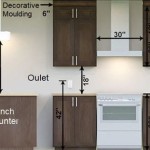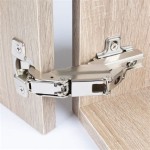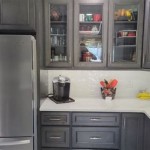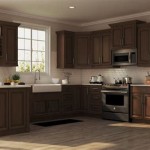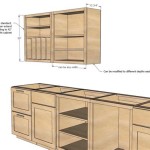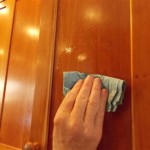Cabinets Without Doors: Exploring Open Storage Concepts for Modern Living
Cabinets without doors, also known as open shelving or open storage solutions, represent a significant shift in interior design, prioritizing accessibility, aesthetics, and a sense of spaciousness. This design choice involves foregoing traditional cabinet doors and instead showcasing the contents of the storage unit. It's a versatile concept applicable to various rooms, including kitchens, living rooms, bathrooms, and home offices, offering unique benefits and considerations compared to traditional closed cabinetry.
The increasing popularity of cabinets without doors stems from several factors. One key influence is the minimalist design trend, which emphasizes decluttering and displaying only essential or visually appealing items. Open shelving allows for a curated display of belongings, turning functional storage into a form of decoration. Furthermore, open storage can create the illusion of a larger space, particularly in smaller rooms, as it eliminates the visual barrier of solid cabinet doors. This design choice also promotes a more accessible and efficient workflow, especially in kitchens where frequently used items are readily available.
However, the decision to incorporate cabinets without doors requires careful consideration of several factors. Maintaining a clean and organized aesthetic is paramount, as open shelving inherently exposes the contents to view. The selection of appropriate materials and finishes is also critical to complement the overall design style of the space. Furthermore, the practical implications of dust accumulation and potential exposure to environmental elements must be addressed.
Aesthetic Advantages and Considerations
The primary aesthetic advantage of cabinets without doors lies in their ability to visually expand a space. The absence of solid doors prevents the storage area from feeling closed off or bulky, which is particularly beneficial in smaller kitchens or rooms with limited natural light. Instead of a wall of closed cabinets, open shelving creates a more airy and open atmosphere. This effect can be further enhanced by using light-colored shelving materials and incorporating strategic lighting.
Furthermore, open shelving allows for the creation of personalized displays. Items stored on open shelves are not merely hidden away; they become part of the room's décor. This presents an opportunity to showcase collections, decorative objects, and well-designed kitchenware. By carefully curating the items displayed, homeowners can create a visually appealing and personalized space that reflects their individual style and interests.
However, the aesthetic appeal of open shelving is contingent upon maintaining a high level of organization. Clutter and disorganization can quickly detract from the desired aesthetic, making the space appear messy and unkempt. Therefore, thoughtful planning and regular maintenance are essential to ensure that open shelving remains a visually appealing feature of the room. This includes decluttering regularly, organizing items by color and size, and using storage containers to conceal less visually appealing items.
The choice of materials and finishes for open shelving also plays a crucial role in its overall aesthetic impact. Materials like solid wood, metal, and glass offer distinct visual characteristics that can complement different design styles. For example, natural wood shelving can add warmth and texture to a space, while metal shelving can create a more industrial or modern look. The finish of the shelving should also be carefully considered to ensure that it coordinates with the other elements in the room.
Functional Benefits and Drawbacks
From a functional perspective, cabinets without doors offer enhanced accessibility. Frequently used items, such as plates, glasses, and cooking utensils, are readily available without the need to open and close cabinet doors. This can significantly improve efficiency in the kitchen, particularly for individuals who cook frequently. The ability to quickly grab and return items can streamline the cooking process and make it more enjoyable.
Open shelving can also facilitate better ventilation. This is particularly beneficial for storing items that require air circulation, such as produce, spices, or cookbooks. The open design allows air to circulate freely, preventing the build-up of moisture and odors. This can help to extend the shelf life of certain items and prevent mold growth.
However, the open nature of cabinets without doors also presents some functional drawbacks. The most significant is the increased exposure to dust and other environmental elements. Items stored on open shelves are more susceptible to accumulating dust, grease, and other contaminants, requiring more frequent cleaning. This can be a particular concern in kitchens where cooking generates significant amounts of airborne particles.
Another functional consideration is the potential for items to be knocked off the shelves. Without the protection of cabinet doors, items are more vulnerable to accidental bumps or collisions. This can be especially problematic in households with children or pets. To mitigate this risk, it is important to ensure that shelving is securely mounted and that items are not placed too close to the edge.
Furthermore, open shelving may not be suitable for storing all types of items. Items that are sensitive to light or temperature changes, such as spices or medications, should be stored in closed cabinets to protect them from degradation. Similarly, items that are unsightly or cluttered should be concealed behind doors to maintain a clean and organized aesthetic.
Practical Implementation and Design Strategies
The successful implementation of cabinets without doors requires careful planning and thoughtful design. The first step is to assess the specific needs and requirements of the space. This includes considering the size of the room, the amount of storage needed, and the overall design style. It is also important to consider the types of items that will be stored on the open shelves and their susceptibility to dust and environmental elements.
Once the needs assessment is complete, the next step is to choose the appropriate materials and finishes. The materials should be durable, easy to clean, and aesthetically pleasing. Common choices include solid wood, metal, glass, and engineered wood products. The finish should be selected to complement the other elements in the room, such as the countertops, flooring, and backsplash.
The layout and configuration of the open shelving should be carefully considered to maximize functionality and aesthetic appeal. Shelves should be spaced appropriately to accommodate the items that will be stored on them. Adjustable shelves can provide greater flexibility in terms of storage options. It is also important to consider the placement of the open shelving in relation to other elements in the room, such as windows, appliances, and doorways.
Lighting plays a crucial role in enhancing the visual appeal of open shelving. Under-cabinet lighting can illuminate the shelves and highlight the items stored on them. This can create a dramatic effect and make the space feel more inviting. Task lighting can also be incorporated to provide additional illumination for specific tasks, such as food preparation or reading.
To mitigate the risk of dust accumulation, regular cleaning is essential. Open shelves should be dusted at least once a week, and items should be wiped down as needed. Using shelf liners can also help to protect the shelves from spills and stains. Consider using storage containers, such as baskets or jars, to conceal smaller items and prevent them from becoming cluttered.
For kitchens, consider the proximity to water sources. Shelving near the sink should be made of water-resistant materials to prevent damage from splashes or spills. In other rooms, such as the living room or bedroom, consider using open shelving to display books, decorative objects, and plants. This can add a touch of personalization and create a more inviting atmosphere.
In summary, cabinets without doors offer a compelling alternative to traditional closed cabinetry, providing a blend of aesthetic appeal and functional benefits. However, successful implementation requires careful consideration of factors such as organization, cleanliness, and material selection. By following these guidelines, homeowners can create a stylish and functional space that reflects their individual style and needs.

33 Smart No Door Kitchen Cabinet Ideas Shelterness

10 Best Kitchen Cabinets No Doors Ideas Inspirations

19 Best Kitchen Cabinets Without Doors Ideas Design Remodel

40 Creative No Door Kitchen Cabinet Ideas Digsdigs

33 Smart No Door Kitchen Cabinet Ideas Shelterness

Diy Budget Open Kitchen Cabinets Build Your Own In A Weekend

Diy Budget Open Kitchen Cabinets Build Your Own In A Weekend

33 Smart No Door Kitchen Cabinet Ideas Shelterness

Alyssa Rosenheck Mint Green Cabinets Sans Doors Transitional Kitchen

Diy Kitchen Remodel Tale
Related Posts

